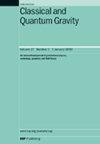A study of dark matter interactions with wormhole metrics in the context of f(Q) gravity
IF 3.6
3区 物理与天体物理
Q2 ASTRONOMY & ASTROPHYSICS
引用次数: 0
Abstract
This study explores the impact of dark matter within the f(Q) gravity framework, emphasizing its role in supporting traversable wormhole solutions. By considering anisotropic matter sources modeled through Bose–Einstein condensate and Einasto density profiles, we derive a novel class of wormhole solutions. The shape function of the wormholes is constructed using the density profile equation and modified field equations, providing a robust foundation for these solutions. The analysis includes the incorporation of a traceless fluid equation of state, which reveals the intricate influence of dark matter on the existence and stability of wormhole structures. To ensure physical plausibility, specific parameter choices are made, confirming that the proposed solutions meet all essential conditions for traversable wormholes. Furthermore, energy conditions are systematically evaluated under four distinct scenarios, and embedding techniques are applied to gain deeper insights into the wormhole geometries. Next, we extend our study to analyze the volume integral quantifier and the anisotropic effect. This work provides a comprehensive perspective on the interplay between dark matter and f(Q) gravity, shedding light on the feasibility of exotic spacetime configurations. Finally, the stability of the derived wormhole solutions is verified using the Tolman–Oppenheimer–Volkoff equation, demonstrating a balance of forces and the physical stability of the models.在f(Q)引力背景下暗物质与虫洞度量相互作用的研究
本研究探讨了暗物质在f(Q)引力框架内的影响,强调了它在支持可穿越虫洞解决方案中的作用。通过考虑通过玻色-爱因斯坦凝聚和埃纳斯托密度剖面模拟的各向异性物质源,我们得到了一类新的虫洞解。利用密度剖面方程和修正的场方程构造了虫洞的形状函数,为这些解提供了坚实的基础。该分析包括纳入无迹流体状态方程,揭示了暗物质对虫洞结构存在和稳定性的复杂影响。为了确保物理上的合理性,对具体参数进行了选择,确认所提出的解决方案满足可穿越虫洞的所有必要条件。此外,系统地评估了四种不同情景下的能量条件,并应用嵌入技术来更深入地了解虫洞的几何形状。接下来,我们将研究扩展到分析体积积分量子和各向异性效应。这项工作为暗物质和f(Q)引力之间的相互作用提供了一个全面的视角,揭示了奇异时空结构的可行性。最后,使用Tolman-Oppenheimer-Volkoff方程验证了导出的虫洞解的稳定性,证明了力的平衡和模型的物理稳定性。
本文章由计算机程序翻译,如有差异,请以英文原文为准。
求助全文
约1分钟内获得全文
求助全文
来源期刊

Classical and Quantum Gravity
物理-天文与天体物理
CiteScore
7.00
自引率
8.60%
发文量
301
审稿时长
2-4 weeks
期刊介绍:
Classical and Quantum Gravity is an established journal for physicists, mathematicians and cosmologists in the fields of gravitation and the theory of spacetime. The journal is now the acknowledged world leader in classical relativity and all areas of quantum gravity.
 求助内容:
求助内容: 应助结果提醒方式:
应助结果提醒方式:


